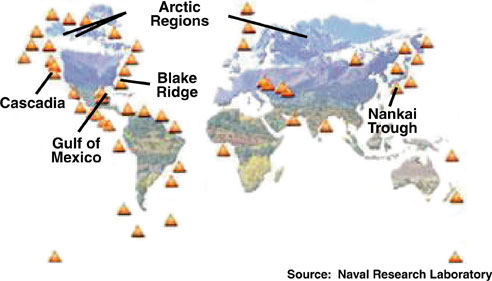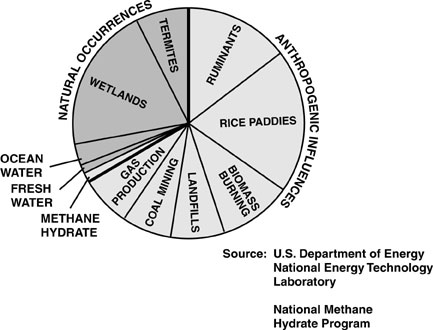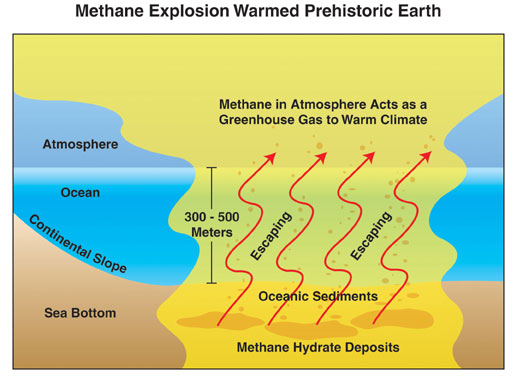2001년 12월 10일
5천5백만 년 전 해저에 냉각되어 있던 막대한 양의 메탄가스가 분출되어 지구의 온도를 화씨 13도(섭씨 7도) 상승시켰다는 나사(NASA)의 새로운 연구결과가 발표되었다. 나사(NASA) 과학자들은 기후변화에 있어 메탄가스의 역할에 대한 이해를 돕기 위해 선사시대의 기후를 컴퓨터 시뮬레이션으로 제작했다. 대부분의 온실가스 연구는 이산화탄소에 중점을 두고 있다. 하지만 메탄가스는 대기에서 이산화탄소보다 20배나 더 강력한 온실가스이다.

이 사진은 전세계적으로 매장되어 있는 메탄 하이드레이트( 냉각된 메탄가스)를 보여주고 있다. 메탄 하이드레이트는 대륙의 경계를 따라 바다 밑바닥 아래에 분포되어 있으며 수심 300~500미터(약 1000~1600 피트) 해저의 차가운 온도와 높은 수압에 의해 동결되어 있다. 메탄은 또한 영구 동토층에도 매장돼 있다. 이 독특한 물질은 냉각된 물분자가 메탄분자를 감싸 생성된 것이다. 메탄은 해양퇴적물에서 유기체가 분해되며 생성된다. 과학자들은 현재 지구온난화를 가속화시키는 메탄가스를 방출시키지 않고 이 막대한 양의 화석연료를 추출할 수 있는지에 대해 연구 중이다.
출처 : 네이블 연구소
지난 200년 동안 대기중의 메탄가스량은 습지와 늪지에서의 유기물 분해와 인류가 초래한 가스 수송관으로부터의 가스 방출, 채탄작업, 관수작업과 가축의 트림 증가 등으로 인해 두 배 이상 높아졌다.
하지만 여기에는 또 다른 메탄가스 방출원이 존재하는데, 바로 유기물 분해로 인해 생성된 해저의 동결되어있는 메탄가스이다.
뉴욕의 나사 고다드 연구소(NASA's Goddard Institute for Space Studies)와 뉴욕과 콜롬비아 대학의 기후시스템연구 센터(NY and Columbia University's Center for Climate Systems Research)의 연구원 가빈 슈미트(Gavin Schmidt)박사는 이렇게 말한다. “이산화탄소 외의 다른 온실가스들이 오늘날 기후변화에 있어 중대한 역할을 하는 것으로 밝혀졌습니다.” “이 연구는 다른 온실가스가 과거에 얼마나 중요했는지, 그리고 앞으로 그 영향력이 얼마나 클 것인가에 대한 이해를 도울 것입니다”
이 연구결과는 2001년 12월 12일, 샌프란시스코 칼리프(Calif)에서 열릴 미국 지구물리학 연맹(American Geophysical Union (AGU))의 가을 학회에서 발표될 것이다.

대부분의 온실가스 연구는 이산화탄소에 중점을 두고 있다. 하지만 메탄가스는 대기 중에서 이산화탄소보다 20배나 더 강력한 온실가스이다. 이 차트는 현재 대기로 방출된 메탄가스의 양의 자연적 요인과 인류가 발생시킨 요인을 보여준다.
자연 요인에는 습지, 흰개미, 바다와 민물에서의 유기물 분해, 그리고 메탄 하이드레이트가 있다. 인류가 발생시킨 요인에는 가축의 트림, 논(벼 수확지), 동식물 폐기물 소각, 쓰레기 매립, 채탄작업, 가스 발생제품 등이 있는데, 이 가운데 논(벼 수확지)와 가축의 트림은 메탄가스 방출의 주 요인이다.
지난 200년간 대기중의 메탄가스 량은 인간의 활동에 의해 두 배나 높아졌다. 어떤 과학자들은 현재의 지구의 열이 바다의 온도를 높이고 해저의 메탄가스를 방출시켜 대기의 메탄가스 량을 증가시킬 것으로 전망한다. 새로운 발견은 5천5백만 년 전, 막대한 양의 메탄가스 방출로 인해 지구의 온도가 화씨 13도(섭씨 7도) 상승되었음을 보여주고 있다.
출처: 미국 에너지기술연구소, 국제 메탄하이드레이트 계획
일반적으로 차가운 온도와 높은 수압은 메탄가스를 해저에 안정적으로 가두어 놓지만 언제나 돌발적인 일이 발생할 수 있다. 팔레오세 고온기(Late Paleocene Thermal Maximum(LPTM)이라 불리는 지구 온난화의 시기가 5천5백만 년 전에 발생되어 약 십만 년 동안 지속되었다. 이것은 현재, 대기 중의 온실가스 증가로 지구의 기온이 상승하여 해저에 매장돼 있던 방대한 양의 메탄가스가 방출되었기 때문이라 한다.
인도대륙 같은 대륙의 이동으로 팔레오세 고온기가 발생되었을 것이라고 슈미트 박사는 말했다. 우리는 인도대륙이 유럽대륙 방면으로 움직여 히말라야 산이 형성되었음을 알고 있다. 이 지층의 융기가 해저 수압을 감소시켜 방대한 메탄가스가 방출되었다. 메탄가스 방출로 인해 대기와 바다가 따듯해졌고, 그 온도 상승으로 인해 더 많은 양의 메탄가스가 분출된 것이다. 일부 과학자들은 현재의 지구 온난화가 앞으로 이와 같은 결과를 일으킬 것이라 예측하고 있다.
메탄(CH4)이 대기 중으로 유입되면 그것은 산소분자(O)와 수소분자(H)와 반응하며 OH라디칼이 된다. 이 OH라디칼은 메탄과 결합하여 새롭게 이산화탄소(CO2)와 수증기(H2O)로 변하는데, 모두 온실가스이다. 과학자들은 방출된 메탄가스가 이산화탄소와 물로 전환되려면 약 10년이 걸린다고 생각했다. 만약 그렇다면 이산화탄소의 생성은 지구 온난화의 주범이 되었을 것이다. 하지만 과학자들이 온난화가 빠르게 진행되었던 팔레오세 고온기 동안 이산화탄소 증가의 증거를 찾아본 결과, 아무것도 찾을 수 없었다.
새로운 연구결과는 메탄가스가 엄청나게 증가하면 OH는 빠르게 없어지고, 남은 메탄가스는 수 백 년 동안 남아서 팔레오세 고온기와 같은 지구 온난화를 가져 온다고 설명한다.
슈미트 박사는 이렇게 말했다. “수십 년간의 메탄가스는 소량이지만 수백 년간 대기 중에 남아 있는 메탄가스는 대기의 온도를 상승시키고 바다의 빙하를 녹여 기후 체계 전체를 바꿉니다. 우리는 수수께끼를 풀었습니다.”
이 연구는 현재 지구온난화에 있어 메탄가스의 역할을 이해하는데 도움을 줄 것이라고 슈미트 박사는 말한다.
“만약 앞으로 기후변화를 줄이기를 원한다면 이산화탄소뿐 아니라 다른 온실가스인 메탄가스와 프레온 가스 등에 대해서도 의식해야 합니다. 그러면 보다 더 넓은 시각을 얻게 되며, 이산화탄소를 줄이는 것보다 대기 중의 메탄가스를 줄이는 것이 더 효율적이라는 것을 곧 알게 될 것입니다.”
선사시대 지구 온도를 상승시킨 메탄가스.
이 그림은 해저에 냉각되어 있던 메탄가스가 대기 중으로 어떻게 풀려나는가를 묘사하고 있다. 차가운 온도와 높은 수압은 메탄가스가 안정적으로 해저에 매장되어 있도록 한다. 하지만 과학자들은 약 5천5백 만 년 전 팔레오세 고온기의 지각 융기로 인한 해저의 수압 감소가 메탄가스를 방출시켰다고 믿고 있다. 그렇게 메탄가스는 대기 중으로 방출되었고 그것은 온실가스 역할을 하여 지구의 온도를 화씨 13도(섭씨 7도) 상승시켰다. 메탄가스 방출로 인해 대기와 바다가 따뜻해지기 시작하면 더 많은 메탄가스가 대기 중으로 풀려날 수 있음을 보여준다.
출처: 데비 맥린
더 많은 정보를 원하시면 이곳을 방문하세요:
http://www.gsfc.nasa.gov/topstory/20011212methane.html
Editor's Note: AGU Time and Location
Wednesday, December 12, 2001, 1:30 PM, Moscone Center Hall D
###
연락처:
Timothy R. Tawney
Goddard Space Flight Center, Greenbelt, Md.
Phone: 301/614-6573 or AGU Press Room 415/905-1007
ttawney@pop100.gsfc.nasa.gov
Krishna Ramanujan
Goddard Space Flight Center, Greenbelt, Md.
Phone: 301/286-3026 or AGU Press Room 415/905-1007
Kramanuj@pop900.gsfc.nasa.gov
December 10, 2001
A tremendous release of methane gas frozen beneath the sea floor heated the Earth by up to 13 degrees Fahrenheit (7 degrees Celsius) 55 million years ago, a new NASA study confirms. NASA scientists used data from a computer simulation of the paleo-climate to better understand the role of methane in climate change. While most greenhouse gas studies focus on carbon dioxide, methane is 20 times more potent as a heat-trapping gas in the atmosphere.

This graphic shows current known methane hydrate, or frozen methane gas, deposits worldwide. Methane hydrate occurs in ocean sediments along continental margins beneath the sea floor where water depths exceed 300 to 500 meters (about 1000 to 1600 feet) and cold temperatures and high pressure keep the methane stable. It also exists in permafrost. This unique substance forms when molecules of frozen water encase molecules of methane. The methane itself is created by decomposing organic matter in ocean sediments. Scientists are currently trying to figure out how to tap these huge stores of fossil fuel, without releasing methane into the atmosphere where it would exacerbate global warming.
Credit: Naval Research Laboratory
In the last 200 years, atmospheric methane has more than doubled due to decomposing organic materials in wetlands and swamps and human aided emissions from gas pipelines, coal mining, increases in irrigation and livestock flatulence.
However, there is another source of methane, formed from decomposing organic matter in ocean sediments, frozen in deposits under the seabed.
"We understand that other greenhouse gases apart from carbon dioxide are important for climate change today," said Gavin Schmidt, the lead author of the study and a researcher at NASA's Goddard Institute for Space Studies in New York, NY and Columbia University's Center for Climate Systems Research. "This work should help quantify how important they have been in the past, and help estimate their effects in the future."
The study will be presented on December 12, 2001, at the American Geophysical Union (AGU) Fall Meeting in San Francisco, Calif.
While most greenhouse gas studies focus on carbon dioxide, methane is 20 times more potent as a heat-trapping gas in the atmosphere. This pie chart shows natural and anthropogenic sources and relative quantities of methane currently released into the atmosphere.
Natural sources include wetlands, termites, decomposing organic materials in ocean and fresh water, and methane hydrate. Anthropogenic influenced sources include livestock flatulence, rice paddies, biomass burning, landfills, coal mining, and gas production, with rice paddies and livestock flatulence being the major sources of methane.
In the last 200 years, atmospheric methane has more than doubled largely due to human influences. Some scientists speculate current global heating could eventually warm the oceans enough to thaw frozen methane beneath the sea floor, leading to an increase of methane in the atmosphere. The findings of this research show that when large amounts of methane were released 55 million years ago, the planet warmed by up to 13 degrees Fahrenheit (7 degrees Celsius).
Credit: U.S. Department of Energy Technology Laboratory, National Methane Hydrate Program
Generally, cold temperatures and high pressure keep methane stable beneath the ocean floor, however, that might not always have been the case. A period of global warming, called the Late Paleocene Thermal Maximum (LPTM), occurred around 55 million years ago and lasted about 100,000 years. Current theory has linked this to a vast release of frozen methane from beneath the sea floor, which led to the earth warming as a result of increased greenhouse gases in the atmosphere.
A movement of continental plates, like the Indian subcontinent, may have initiated a release that led to the LPTM, Schmidt said. We know today that when the Indian subcontinent moved into the Eurasian continent, the Himalayas began forming. This uplift of tectonic plates would have decreased pressure in the sea floor, and may have caused the large methane release. Once the atmosphere and oceans began to warm, Schmidt added, it is possible that more methane thawed and bubbled out. Some scientists speculate current global heating could eventually lead to a similar scenario in the future if the oceans warm substantially.
When methane (CH4) enters the atmosphere, it reacts with molecules of oxygen (O) and hydrogen (H), called OH radicals. The OH radicals combine with methane and break it up, creating carbon dioxide (CO2) and water vapor (H2O), both of which are greenhouse gases. Scientists previously assumed that all of the released methane would be converted to CO2 and water after about a decade. If that happened, the rise in CO2 would have been the biggest player in warming the planet. But when scientists tried to find evidence of increased CO2 levels to explain the rapid warming during the LPTM, none could be found.
The models used in the new study show that when you greatly increase methane amounts, the OH quickly gets used up, and the extra methane lingers for hundreds of years, producing enough global warming to explain the LTPM climate.
"Ten years of methane is a blip, but hundreds of years of atmospheric methane is enough to warm up the atmosphere, melt the ice in the oceans, and change the whole climate system," Schmidt said. "So we may have solved a conundrum."
Schmidt said the study should help in understanding the role methane plays in current greenhouse warming.
"If you want to think about reducing future climate change, you also have to be aware of greenhouse gases other than carbon dioxide, like methane and chlorofluorocarbons," said Schmidt. "It gives a more rounded view, and in the short-term, it may end up being more cost-efficient to reduce methane in the atmosphere than it is to reduce carbon dioxide."

This graphic depicts the transfer of frozen methane deposits beneath the sea floor to the atmosphere. Generally, cold temperatures and high pressure keep the methane stable beneath the sea floor. But during the Late Paleocene Thermal Maximum (LPTM), around 55 million years ago, scientists believe movement of tectonic plates reduced the pressure in the sea floor and released the methane. When that happened, the methane bubbled out into the atmosphere, where it acted as a greenhouse gas, and heated the planet by up to 13 degrees Fahrenheit (7 degrees Celsius). It is also possible that once the atmosphere and oceans began to warm, more methane thawed and bubbled out.
Credit: Debbi McLean,
For more information please see:
http://www.gsfc.nasa.gov/topstory/20011212methane.html
Editor's Note: AGU Time and Location
Wednesday, December 12, 2001, 1:30 PM, Moscone Center Hall D
###
Contact:
Timothy R. Tawney
Goddard Space Flight Center, Greenbelt, Md.
Phone: 301/614-6573 or AGU Press Room 415/905-1007
ttawney@pop100.gsfc.nasa.gov
Krishna Ramanujan
Goddard Space Flight Center, Greenbelt, Md.
Phone: 301/286-3026 or AGU Press Room 415/905-1007
Kramanuj@pop900.gsfc.nasa.gov

